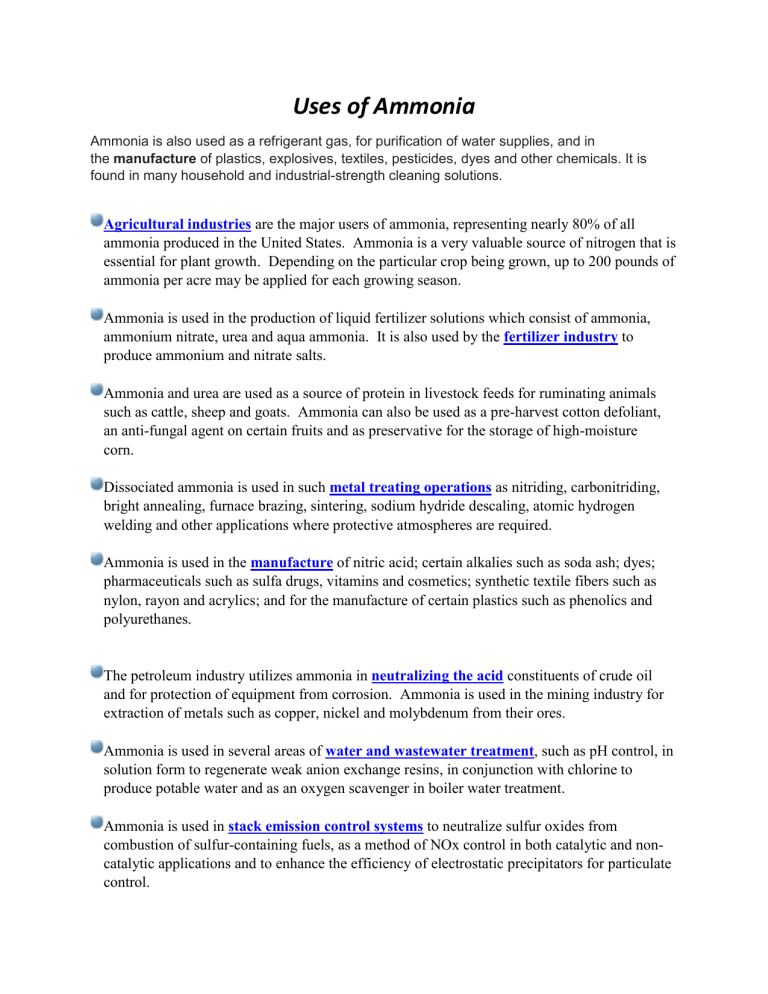
Uses of Ammonia Ammonia is also used as a refrigerant gas, for purification of water supplies, and in the manufacture of plastics, explosives, textiles, pesticides, dyes and other chemicals. It is found in many household and industrial-strength cleaning solutions. Agricultural industries are the major users of ammonia, representing nearly 80% of all ammonia produced in the United States. Ammonia is a very valuable source of nitrogen that is essential for plant growth. Depending on the particular crop being grown, up to 200 pounds of ammonia per acre may be applied for each growing season. Ammonia is used in the production of liquid fertilizer solutions which consist of ammonia, ammonium nitrate, urea and aqua ammonia. It is also used by the fertilizer industry to produce ammonium and nitrate salts. Ammonia and urea are used as a source of protein in livestock feeds for ruminating animals such as cattle, sheep and goats. Ammonia can also be used as a pre-harvest cotton defoliant, an anti-fungal agent on certain fruits and as preservative for the storage of high-moisture corn. Dissociated ammonia is used in such metal treating operations as nitriding, carbonitriding, bright annealing, furnace brazing, sintering, sodium hydride descaling, atomic hydrogen welding and other applications where protective atmospheres are required. Ammonia is used in the manufacture of nitric acid; certain alkalies such as soda ash; dyes; pharmaceuticals such as sulfa drugs, vitamins and cosmetics; synthetic textile fibers such as nylon, rayon and acrylics; and for the manufacture of certain plastics such as phenolics and polyurethanes. The petroleum industry utilizes ammonia in neutralizing the acid constituents of crude oil and for protection of equipment from corrosion. Ammonia is used in the mining industry for extraction of metals such as copper, nickel and molybdenum from their ores. Ammonia is used in several areas of water and wastewater treatment, such as pH control, in solution form to regenerate weak anion exchange resins, in conjunction with chlorine to produce potable water and as an oxygen scavenger in boiler water treatment. Ammonia is used in stack emission control systems to neutralize sulfur oxides from combustion of sulfur-containing fuels, as a method of NOx control in both catalytic and noncatalytic applications and to enhance the efficiency of electrostatic precipitators for particulate control. Ammonia is used as the developing agent in photochemical processes such as white printing, blue printing and in the diazo duplication process. Ammonia is a widely used refrigerant in industrial refrigeration systems found in the food, beverage, petro-chemical and cold storage industries. Ammonia is used in the rubber industry for the stabilization of natural and synthetic latex to prevent premature coagulation. The pulp and paper industry uses ammonia for pulping wood and as a casein dispersant in the coating of paper. The food and beverage industry uses ammonia as a source of nitrogen needed for yeast and microorganisms. The decomposition of ammonia serves as a source of hydrogen for some fuel cell and other applications. Ammonia is used by the leather industry as a curing agent, as a slime and mold preventative in tanning liquors and as a protective agent for leathers and furs in storage. Weak ammonia solutions are also widely used as commercial and household cleaners and detergents. o o o o Ammonia is a very important industrial chemical, and is used widely in both its pure form and as a feedstock for a wide variety of other chemicals. Ammonia ranks second behind sulfuric acid in the quantity produced worldwide per year. Ammonia itself is used: o As a fertiliser. o In many alkaline cleansers, such as window and floor cleaners. o As a refrigerant gas. Ammonia is used in the manufacture of: o Fertilisers, such as ammonium sulfate, ammonium nitrate, ammonium hydrogen phosphate, and urea. o Nitric acid, which is used to manufacture: o Ammonium nitrate fertiliser. o Dyes. o Fibres and plastics. o Explosives, such as ammonium nitrate, trinitrotoluene (TNT) and nitroglycerine. Cyanides, which are used to: o Manufacture synthetic polymers, such as nylon and acrylics. o Extract gold from ore bodies.






